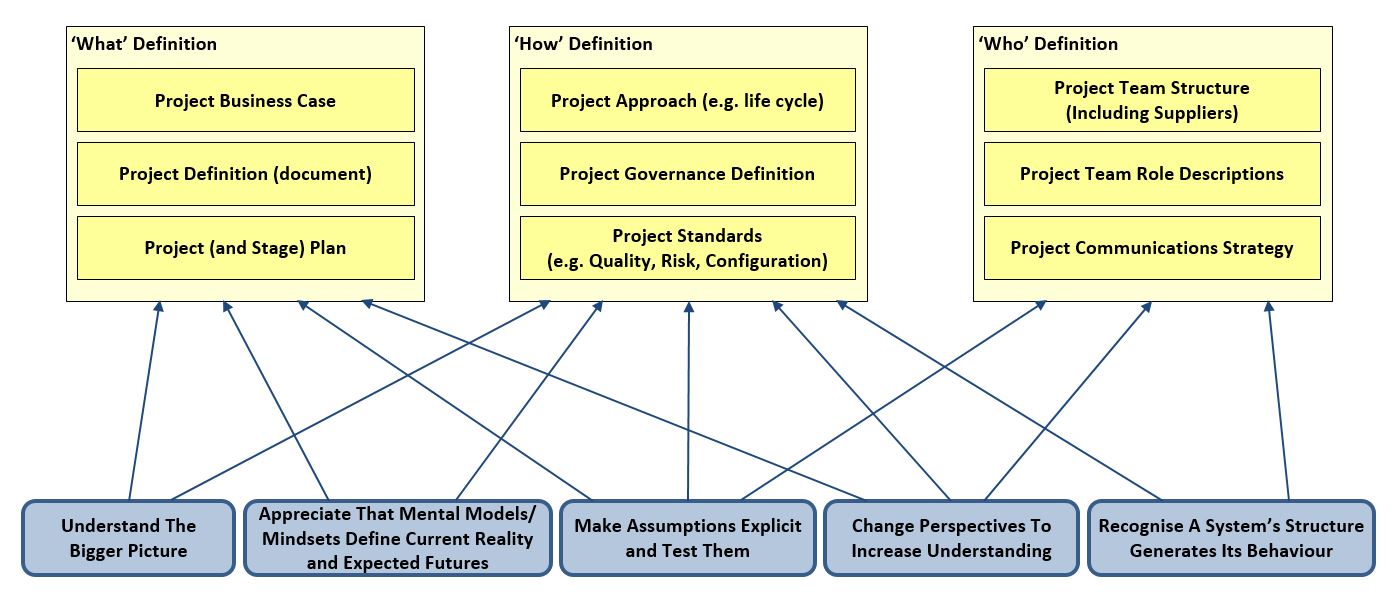Using systems thinking to establish the right project

Welcome to the latest in a series of posts that aim to make the case for applying systems thinking to project management. The intention is to start a discussion with the broader APM community to share examples of where systems thinking has made a real difference to their projects and use this in turn to raise awareness of the main benefits and potential cost savings that a systems thinking-based approach can bring.
This post considers how systems thinking can help establish the right project to develop the solution to a situation needing improvement or an opportunity to be addressed by a new product or service.
Defining the project what, how and who
Previous posts, linked below, described the process of using systems thinking. This post focuses on using the systems thinking principles to enhance existing project management methodologies. A broader description of systems thinking and its application to project management can be found in this Systems Thinking SIG paper.
The main project definition artefacts are given below and shown in the diagram. For all of them, the principles of not jumping to quick conclusions and of making assumptions explicit and testing them should be applied. Include a risk that each assumption is incorrect, together with its consequences, on the project risk log.
- What: business case, definition and (stage) plans
- When developing the business case and project definition, ensure the full scope is covered by changing perspectives and considering the bigger picture and overall project context (including looking outside the proposed scope to confirm it is complete).
- When developing the project plan and/or stage plans, appreciate that mental models (or mindset) define current reality and expected futures. Consider whether the assumptions they imply are valid.
- How: project approach, governance and project standards
- When defining the project approach (which includes project development strategy and life cycle definition), understand the end users’ context for receiving project deliverables and appreciate mental models and mindset define current reality and expected futures.
- When defining the governance structure, recognise that system structure generates behaviour and consider the behaviours it is likely to drive. When defining project standards (e.g. for quality, risks and communications), consider how these standards will be applied by the different actors by considering them from their perspectives.
- Who: team structure (including suppliers), role descriptions and communications strategy
- When defining the project team structure and role descriptions, recognise that system structure generates behaviour. Consider team structure, approach and standards from the perspective(s) of the supplier(s) on the project.

Main benefits
The main benefits from using systems thinking during project establishment are:
- Clearly defined project goals and objectives:
- Improved clarity of project goals and objectives because of a better understanding of the project context and the perspectives of all involved.
- More appropriate definition of project approach, benefits and risks as a result of a more complete understanding of the context within which the project will be delivered.
- More persuasive project business case:
- More realistic project plans and more accurate cost and schedule estimates due to the more thorough pre-project planning enabled by systems thinking.
- Better tailored project approach to the context in which the solution will be developed and deployed as a result of the fuller understanding of the problem, solution, project context and stakeholders.
- More appropriate project governance structure:
- Better defined, clearer and more easily communicated team structure and team roles with no role overlaps or responsibility gaps.
- Improved project monitoring and control from both a complete fuller definition of project scope and a governance structure considered from the perspectives of all involved.
- Quicker project team mobilisation and increased commitment to project success:
- Quicker project mobilisation because of the clearer presentation to the (new) project team of the description of the problem, its proposed solution and the project to develop and deploy this.
- Increased commitment to project success from sponsors due to more accurate cost and schedule forecasts as a result of the fuller understanding of the problem and solution provided by systems thinking.
Conclusion
Establishing the right project enables the project success factors described in the APM Conditions For Project Success publication to be met. It enables:
- Clearly identified project goals and objectives from the better understanding of the problem and the solution enabled by systems thinking.
- Thorough pre-project planning from the broader consideration of the solution context, perspectives of the project participants and recipients, and consideration of the mindset(s) the project team brings to establishing the project.
- More secure funding resulting from a more complete, persuasive and accurate business case.
- Supportive participant organisation(s), committed to project success, with team members and end users engaged as a result of considering the project content, approach and governance from their perspectives.
- Effective governance of competent project teams using proven methods, tools and standards tailored to the project and its context.
Share your thoughts
Please share your thoughts and examples of where systems thinking has made a real difference to your projects by joining the discussion using the comments section below, joining the APM Systems Thinking SIG community or via the contact section on the APM SIG website.
Read other blogs in this series:
Applying systems thinking to project management
Using systems thinking to identify the right problem
Using systems thinking to define the right solution
Using systems thinking to execute the project right
How Portsmouth council used systems thinking to deliver a better service and reduce costs
Applying systems thinking to project management: summary and last thoughts
Image: Who is Danny/Shutterstock.com


0 comments
Log in to post a comment, or create an account if you don't have one already.